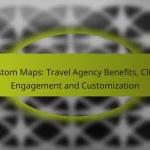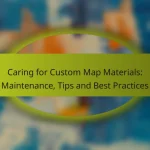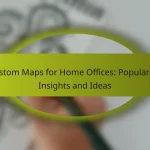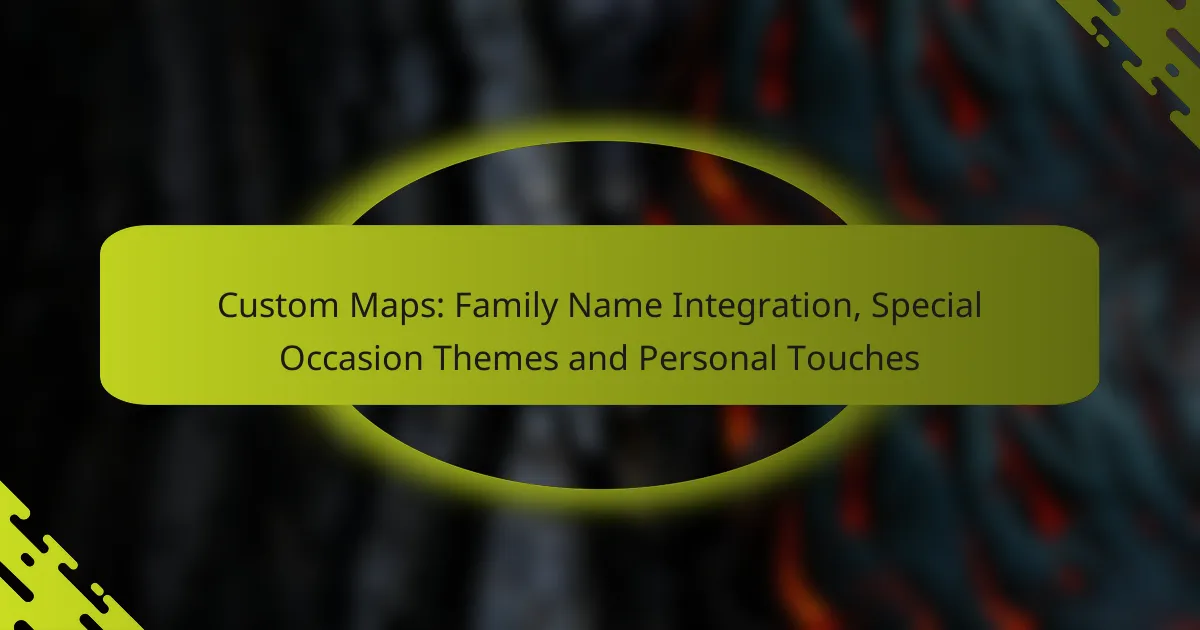Custom maps offer a unique way to enhance personalization by creating tailored visual experiences that align with individual preferences. The pricing of these maps is determined by factors such as design complexity and data integration, allowing for informed budgeting decisions. Ultimately, the value of custom maps lies in their ability to improve user engagement and decision-making, making them a worthwhile investment for many organizations.
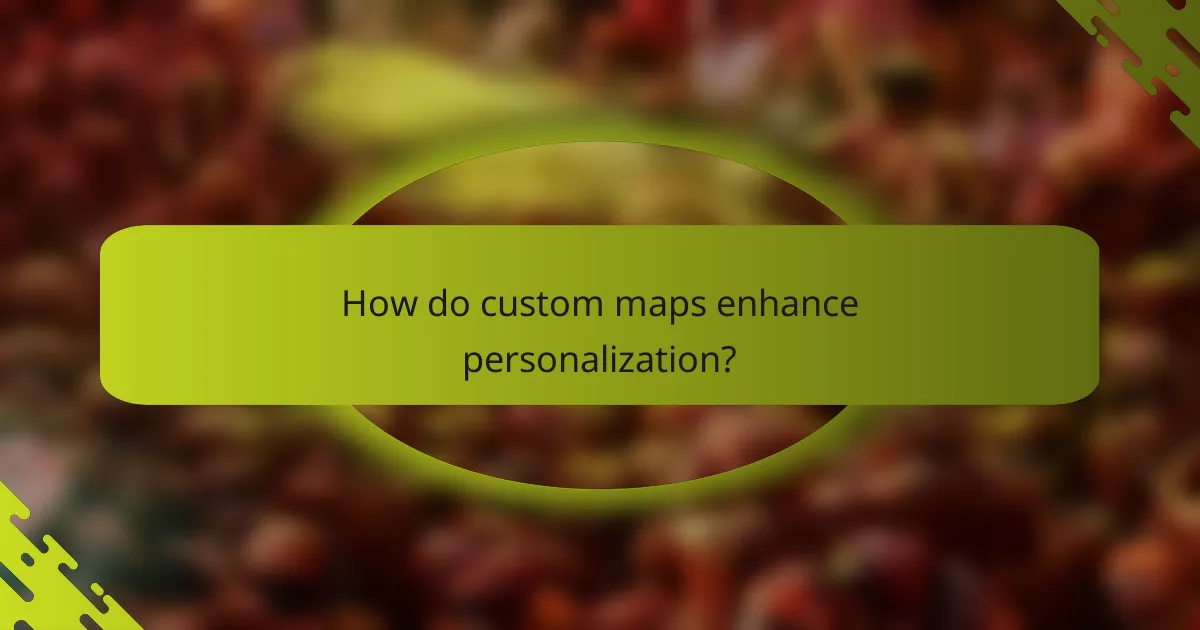
How do custom maps enhance personalization?
Custom maps enhance personalization by providing tailored visual experiences that resonate with individual preferences and needs. They allow users to interact with content that is relevant to them, fostering a deeper connection to the information presented.
Tailored user experiences
Custom maps create tailored user experiences by incorporating specific data and features that align with user interests. For example, a travel app might offer personalized routes based on a user’s previous destinations or preferred activities, such as hiking or dining.
This level of customization can significantly improve user satisfaction, as individuals feel that the content is designed specifically for them. Businesses should consider integrating user feedback to refine map features continually.
Improved engagement metrics
Engagement metrics improve when users interact with custom maps, as they often spend more time exploring personalized content. Studies suggest that users are more likely to click on features that reflect their interests, leading to higher interaction rates.
To maximize engagement, businesses should regularly analyze user behavior on custom maps and adjust features accordingly. This could include adding new points of interest or enhancing visual elements that attract attention.
Increased brand loyalty
Increased brand loyalty often results from the positive experiences users have with custom maps. When users find value in personalized content, they are more likely to return to the service and recommend it to others.
To foster loyalty, companies should ensure that their custom maps are not only visually appealing but also functional and easy to navigate. Regular updates and improvements can help maintain user interest and satisfaction over time.

What factors influence custom map pricing?
Custom map pricing is influenced by several key factors, including design complexity, size and scale, and data integration requirements. Understanding these elements can help you estimate costs and make informed decisions when commissioning a custom map.
Design complexity
The complexity of the design significantly affects the pricing of custom maps. More intricate designs, such as those featuring detailed illustrations or specialized themes, typically require more time and expertise, leading to higher costs. Simple, straightforward maps may be more affordable due to reduced labor and design time.
When considering design complexity, think about the level of detail you need. For example, a basic road map will generally cost less than a custom topographic map that includes elevation changes and landmarks. It’s essential to communicate your vision clearly to the designer to get accurate pricing.
Size and scale of the map
The size and scale of a custom map also play a crucial role in determining its price. Larger maps require more materials and can take longer to produce, which can increase costs. Additionally, the scale affects the level of detail that can be included, impacting both design time and complexity.
For instance, a small map for a local event might be relatively inexpensive, while a large-scale map for a city or region could range from hundreds to thousands of dollars, depending on the specifics. Always consider the intended use of the map when deciding on size and scale to ensure it meets your needs without overspending.
Data integration requirements
Data integration requirements can significantly influence custom map pricing. If your map needs to incorporate various data sources, such as geographic information systems (GIS) or real-time data feeds, the complexity and cost will increase. Integrating multiple datasets often requires specialized skills and tools, which can add to the overall expense.
When planning a custom map, evaluate the data you need to include. For example, a map that integrates demographic data or environmental statistics may require more advanced technology and expertise, leading to higher costs. It’s advisable to discuss your data needs upfront with the designer to get a clear understanding of any additional charges that may arise.

What are the value expectations for custom maps?
Value expectations for custom maps center around their ability to enhance user experience, improve decision-making, and provide tailored insights. Customers typically anticipate a return on investment through increased engagement, satisfaction, and competitive differentiation.
Return on investment
Return on investment (ROI) for custom maps can be significant, particularly when they are aligned with specific business goals. Companies often see increased customer engagement and retention, which can translate into higher sales. For example, businesses that utilize custom maps for location-based marketing may experience a boost in foot traffic and online conversions.
To maximize ROI, consider factors such as the target audience’s needs and the map’s intended use. Investing in user-friendly design and functionality can lead to better outcomes. Tracking metrics like user interaction and sales growth can help gauge effectiveness over time.
Long-term customer satisfaction
Long-term customer satisfaction with custom maps hinges on their relevance and usability. Maps that are tailored to user preferences and provide clear, actionable insights tend to foster loyalty. Regular updates and improvements based on user feedback can further enhance satisfaction levels.
To ensure ongoing satisfaction, engage with users to understand their evolving needs. Offering customization options can also empower users, making them feel more connected to the product. This, in turn, can lead to positive word-of-mouth and repeat business.
Competitive advantages
Custom maps can provide competitive advantages by differentiating a business from its competitors. Unique, visually appealing maps that offer valuable insights can attract customers and enhance brand perception. For instance, a real estate company using custom maps to highlight neighborhood features may stand out in a crowded market.
To leverage this advantage, focus on creating maps that address specific pain points or interests of your target audience. Consider integrating advanced features like real-time data or interactive elements to further enhance the user experience. Staying ahead of trends in mapping technology can also solidify your position in the market.
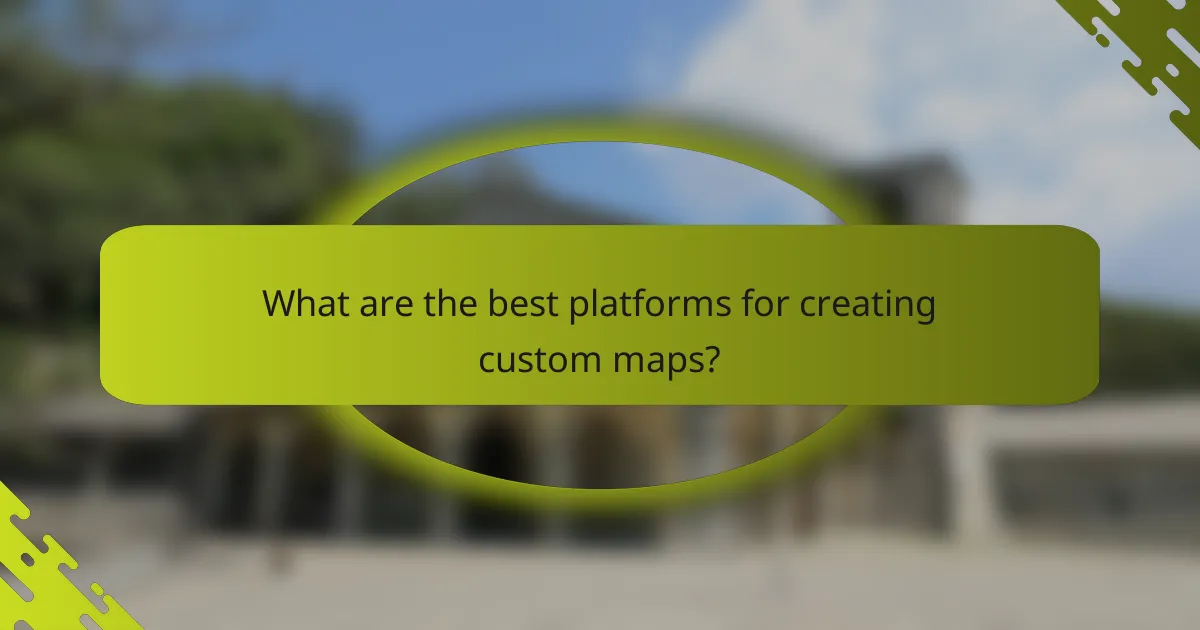
What are the best platforms for creating custom maps?
Several platforms excel in creating custom maps, each offering unique features and capabilities. The best choice depends on your specific needs, such as ease of use, customization options, and integration capabilities.
Mapbox
Mapbox is a popular platform for designing custom maps with a focus on high-quality visuals and extensive customization options. It allows users to create maps using its powerful APIs and SDKs, making it suitable for developers and designers alike.
Key features include customizable styles, data visualization tools, and support for various geographic data formats. Pricing typically starts with a free tier, which can be beneficial for small projects, while larger applications may incur costs based on usage and features.
Google Maps API
The Google Maps API is widely used for integrating maps into web applications. It offers robust features, including geolocation, route planning, and street view, making it a versatile choice for businesses and developers.
Customization options are somewhat limited compared to Mapbox, but it provides a reliable and familiar interface. Pricing is based on usage, with a free tier available that covers a certain number of requests per month, making it accessible for many users.
ArcGIS Online
ArcGIS Online is a comprehensive mapping platform that caters to professionals in various industries, including urban planning and environmental science. It offers advanced analytical tools and extensive data layers, allowing users to create detailed and informative maps.
This platform is particularly useful for organizations that require collaboration and sharing capabilities. Pricing is subscription-based, with different tiers depending on the features and data storage needed, making it suitable for both small teams and large enterprises.

How to choose the right custom map provider?
Choosing the right custom map provider involves evaluating their experience, service quality, and pricing. Focus on their portfolio, customer support, and how their pricing aligns with your budget and project needs.
Evaluate portfolio and case studies
Start by reviewing the provider’s portfolio to see examples of their previous work. Look for case studies that demonstrate their ability to handle projects similar to yours, paying attention to the quality and creativity of their maps.
Consider the variety of map styles they offer, such as topographic, thematic, or interactive maps. A diverse portfolio indicates flexibility and expertise, which can be crucial for meeting your specific requirements.
Assess customer support and service
Effective customer support is essential for a smooth mapping project. Evaluate how responsive the provider is to inquiries and whether they offer multiple channels of communication, such as email, phone, or live chat.
Additionally, inquire about their project management process. A provider that offers regular updates and is willing to collaborate closely with you can significantly enhance the overall experience and outcome of your custom map.
Compare pricing structures
Pricing for custom maps can vary widely based on factors like complexity, size, and features. Some providers may charge a flat fee, while others might use a tiered pricing model based on the level of customization required.
Request quotes from multiple providers to compare costs effectively. Be sure to clarify what is included in the price, such as revisions, file formats, and delivery timelines, to avoid unexpected expenses.

What are the emerging trends in custom map personalization?
Emerging trends in custom map personalization include the integration of advanced technologies like augmented reality, artificial intelligence, and e-commerce platforms. These innovations enhance user experience by providing tailored content and interactive features that cater to individual preferences.
Incorporation of augmented reality
Augmented reality (AR) is transforming custom map personalization by overlaying digital information onto the physical world. Users can interact with maps in real-time, viewing additional layers of data such as points of interest, navigation prompts, or historical context. This immersive experience can significantly enhance engagement and understanding of geographical areas.
For instance, a tourist exploring a city can use an AR-enabled map to see nearby attractions, read reviews, and access navigation tips directly through their smartphone. This feature not only makes the map more informative but also encourages exploration.
Utilization of AI for data analysis
Artificial intelligence is increasingly utilized in custom map personalization to analyze user data and preferences. By processing large datasets, AI can identify patterns and suggest personalized routes, locations, or experiences based on individual behavior and interests. This capability allows for a more tailored mapping experience.
For example, a delivery service can leverage AI to optimize routes based on traffic patterns and customer locations, improving efficiency and reducing costs. Users benefit from faster, more accurate services while businesses can enhance customer satisfaction and operational efficiency.
Integration with e-commerce platforms
Integrating custom maps with e-commerce platforms allows businesses to create seamless shopping experiences. Maps can display product availability, store locations, and promotional offers, guiding users to make informed purchasing decisions. This trend is particularly beneficial for local businesses looking to attract foot traffic.
For instance, a retail chain can use a custom map to show nearby stores with specific inventory, enabling customers to find products quickly. This integration not only enhances user convenience but also drives sales by connecting online browsing with in-store shopping.

